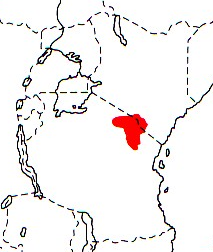Weaver species
Choose different species from drop-down list and press 'Go' button. See Full species list.Taveta Golden Weaver Ploceus castaneiceps
IUCN: Least concern Discovery: 089Categories: golden, wetland,
News items about species
Discovery
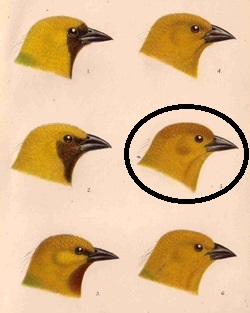
figure from Sharpe (1890) 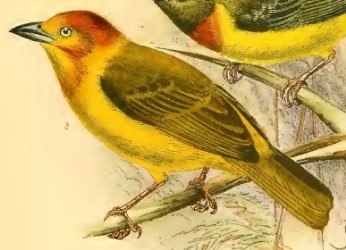
figure from Reichenow (1902) 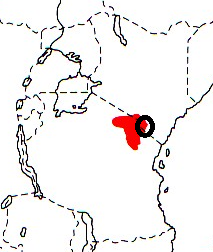
distribution, type locality circled IntroductionThe Taveta Golden Weaver was formally described by Richard Bowdler Sharpe, an English zoologist and ornithologist who worked as curator of the bird collection at the British Museum of natural history.The Taveta Golden Weaver was collected by HCV Hunter, an English zoologist and hunter who is better known for discovering and collecting the Critically Endangered antelope, the Hirola or "Hunter's antelope", in 1888 along the Tana River in Kenya. Hunter collected the Taveta Golden Weaver along the Useri River (Shelley 1905b) near Taveta. Hunter collected a large number of birds in the Mt Kilimanjaro area in June to August 1888. The collection was written up in 1889 by Shelley, who described several new species. However, he listed the weaver as an Eastern Golden Weaver and it was only in 1890 that Sharpe realised that Hunter's weaver was a new species. The first illustration of the Taveta Golden Weaver was of the head of the type specimen, published by Sharpe (1890) with the heads of similar species. The next illustration was of an adult male in Reichenow (1902), considered to be a new subspecies at the time. Scientific citationHyphantornis castaneiceps Sharpe 1890, Cat. Birds. Brit. Mus., 13, p.448 Taveta, Kenya.Meaning of namescastaneiceps, Latin: castaneus, chestnut-coloured; -ceps, capped, crowned.First English nameRufous-crowned Golden Weaver (Shelley 1905b).Alternate namesBrown-naped Golden Weaver, Rufous-crowned Golden Weaver, Taveta Weaver.CollectorHCV Hunter.Date collectedJuly 1888.Locality collectedUseri River, Taveta, Kenya.Type specimensThe type is in the Bristish Museum (BM 1889.3.21.71). |
The above is based on Weaver Wednesday 2, a weekly series about the discovery of each weaver species.
This species text first appeared as
Weaver Wednesday [206] - Discovery [89]: Taveta Golden Weaver on 2016-05-25
1. Basic biology
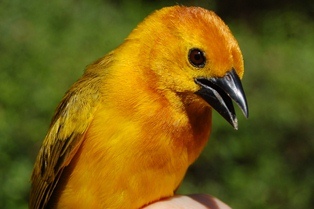

More measurements are needed for this species - a sample of 7 males ringed near Arusha had larger wing and tail and shorter bills than the measurements provided for 8 males (possibly museum specimans) in Birds of Africa). It was first collected near the town Taveta, giving rise to its English name. Distribution. In Kenya, the The Taveta Golden Weaver is found in the Amboseli and Taveta areas, and Lake Jipe. In Tanzania, it occurs along the Pangani River, around Mt Meru and Kilimanjaro (see map right, based on Birds of Africa). No subspecies of the Taveta Golden Weaver are recognised, although one other has been proposed. It is common but very local. Habitat. The Taveta Golden Weaver inhabits woodland and dry bush country, and moves into swampy lowlands to breed. Food.
The diet of the The Taveta Golden Weaver is seeds, including grass seeds, and maize, and ants have been recorded.
Breeding. The Taveta Golden Weaver is probably polygynous. It breeds in colonies in swampy or flooded areas. Breeding areas may be deserted suddenly and completely, for weeks or months at a time. It is not clear if this follows a regular pattern in Tanzania. The nest is spherical or ovoid with no entrance tube but a slight porch. The nest is woven of strips of reed leaf-blades. Nests are usually suspended over water in reedbeds or bulrushes, and sometimes in low trees overhanging water. It sometimes nests is association with other weavers. The eggs are olive green with fine darker flecks. Not much more is known about breeding. |
The above is based on Weaver Wednesday, a weekly series about weaver species.
This species text first appeared as
Weaver Wednesday [36]: Taveta Golden Weaver
on 2013-02-20
2. Breeding facts
| Pair bond presumed polygnous Breeding season Oct-May in Kenya, and Sept-Jan and Apr-May in Tanzania Nest site suspended over water in reeds, bulrushes (Typha) or overhanging tree Nest building No information Colony size Colonial Clutch size 3 eggs Egg colour olive green with fine darker flecks Egg size one measured 23 x 16 mm Incubation in captivity, incubation period 13 days Chicks and nestling period in captivity, nestling period 16 days |
Breeding information based on Handbook of the Birds of the World, Vol. 15.
3. Photos of Weaver Nests
 Vm 30868 |  Vm 19097 |  Vm 13810 |  Vm 3483 |  Vm 997 |
Thumb-nails of most recent PHOWN records - click on one to see its full record
See all PHOWN records for this species here.
PHOWN (Photos of Weaver Nests) provides valuable info on breeding distribution and colony sizes of weavers.
You can contribute by registering and submitting photos at Virtual Museum webpage.
4. Breeding distribution
Google map showing distribution (For species with small ranges you need to zoom in at the correct area to see the range):
yellow blob - range of weaver species; read more about this here.
![]() - PHOWN records with photos
- PHOWN records with photos
![]() - PHOWN records with no photos (Nest Record Cards, other records)
- PHOWN records with no photos (Nest Record Cards, other records)
![]() - Birdpix records
- Birdpix records
![]() - comments on out of range records, or interesting records
- comments on out of range records, or interesting records
![]() - type locality
- type locality
CLICK on the marker on the map to see individual record details.
5. Range changes
Not South African speciesThe above is based on Weaver Wednesday 3, a weekly series about range changes in South African weaver species.
This species text first appeared as
n/a











